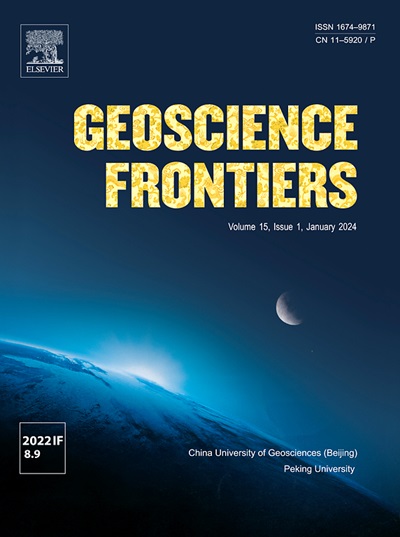Tectonic setting of the Youjiang giant tin belt, South China: New findings from the Pingna W-Sn deposit
IF 8.5
1区 地球科学
Q1 GEOSCIENCES, MULTIDISCIPLINARY
引用次数: 0
Abstract
Growing evidence suggests that extensional/transtensional settings are favorable for the formation of tin deposits, yet the underlying geodynamic mechanism remains equivocal. The Pingna W-Sn deposit, found in the underexplored interior of the giant tin belt within the Youjiang Basin, South China, offers a unique opportunity to explore and better constrain the current geodynamic model for tin mineralization. This deposit, composed of NW- to NWN-striking vein swarms with W-Sn mineralization, is hosted in the Middle Triassic clastic rocks without igneous rocks near its mineralization. Structural analysis indicates that the Youjiang fold-and-fault belt and the ore-related structures in the Pingna deposit experienced five deformation phases (D1–D5). The pre-ore NE-striking compression (D1; σv = σ3) initiated fault-fracture meshes, followed by NE-striking extension (D2), while NW-striking compression (D3; σv = σ2) enhanced the vertical connectivity of the meshes. Syn-mineralization E-W extension (D4; σv = σ1) facilitated upward through-going flow and hydrothermal fluids infilled the meshes, forming a fault-vein system. The mineralized veins were cut across by post-ore WNW-striking oblique fault with sinistral and normal components (D5). The meshes dictated Sn-W orebodies localization. Hydrothermal veins formed in three stages: (I) muscovitization-bordered tin-dominated quartz vein swarms along the Pingna fault; (II) W-dominated lit-par-lit vein system; and (III) barren calcite veins crosscutting the former veins. The Pingna W-Sn mineralization formed during the Late Cretaceous as constrained by the cassiterite (Cst1) U-Pb age of 95.6 ± 2.4 Ma (2σ, MSWD = 1.2), muscovite (Ms1) 40Ar-39Ar plateau age of 93.9 ± 0.1 Ma (2σ, MSWD = 1.7), and molybdenite Re-Os age of 92.9 ± 1.2 Ma (2σ, MSWD = 0.3). Outward lateral zoning of the Sn-W mineralization, as well as associated muscovitization and silicification implies the epicenter of hydrothermal fluid is near the No. II vein swarm. Contemporaneous felsic dykes coupling with the inferred intrusions demonstrate that the Pingna deposit is a distal hydrothermal W-Sn deposit. The releasing bend of the NW-striking Pingna fault controlled the distribution of tin-dominated mineralization, while the anticlines controlled the tungsten-dominated mineralization. Our findings suggest that the localization and formation of the Pingna W-Sn veins were controlled by Late-Cretaceous regional transtensional stress field and polyphase deformation, rather than previously proposed local extension of the Youjiang Basin. The discovery of the Pingna W-Sn deposit highlights the interior of the Youjiang Basin as a promising area for tungsten-tin exploration.

南右江巨型锡带的构造背景:坪那钨锡矿床的新发现
越来越多的证据表明,伸展/张拉环境有利于锡矿床的形成,但其潜在的地球动力机制仍不明确。坪那钨锡矿床位于中国南部右江盆地巨型锡带内部,为探索和更好地约束当前锡成矿地球动力学模型提供了独特的机会。该矿床赋存于中三叠统碎屑岩中,成矿附近无火成岩,由北西向至北西向的脉群组成,具有西锡成矿作用。构造分析表明,坪纳矿床右江褶皱断裂带及与矿有关的构造经历了d1 ~ d5 5期变形。矿前ne向压缩(D1;σv = σ3)引发断缝网,其次是北东向伸展(D2)和北西向挤压(D3);σv = σ2)增强了网格的垂直连通性。同成矿E-W伸展(D4;σv = σ1)有利于上行贯通流动,热液流体充填网格,形成断脉系统。矿化矿脉被矿后西北西走向的斜断层切断,斜断层具有左、正分量(D5)。网格显示Sn-W矿体定位。热液脉的形成分三个阶段:(1)沿坪纳断裂带以白泥化为边界的锡为主石英脉群;(II)以w为主的亮-半亮静脉系统;(3)与原方解石脉相交的秃方解石脉。锡石(Cst1) U-Pb年龄为95.6±2.4 Ma (2σ, MSWD = 1.2),白云母(Ms1) 40Ar-39Ar高原年龄为93.9±0.1 Ma (2σ, MSWD = 1.7),辉钼矿Re-Os年龄为92.9±1.2 Ma (2σ, MSWD = 0.3),形成于晚白垩世。Sn-W型矿化的向外横向分带及其伴生的白蜡化和硅化作用表明,热液流体的震中位于第2段附近。II脉群。同生长英岩脉与推断出的侵入岩耦合表明,坪那矿床为远端热液型钨锡矿床。北西向的坪那断裂释放弯曲控制了锡矿化的分布,背斜控制了钨矿化的分布。研究结果表明,坪那钨锡脉的定位和形成受晚白垩世区域张拉应力场和多期变形的控制,而非先前认为的右江盆地局部伸展作用。坪那钨锡矿床的发现,突出了右江盆地内部钨锡勘查的前景。
本文章由计算机程序翻译,如有差异,请以英文原文为准。
求助全文
约1分钟内获得全文
求助全文
来源期刊

Geoscience frontiers
Earth and Planetary Sciences-General Earth and Planetary Sciences
CiteScore
17.80
自引率
3.40%
发文量
147
审稿时长
35 days
期刊介绍:
Geoscience Frontiers (GSF) is the Journal of China University of Geosciences (Beijing) and Peking University. It publishes peer-reviewed research articles and reviews in interdisciplinary fields of Earth and Planetary Sciences. GSF covers various research areas including petrology and geochemistry, lithospheric architecture and mantle dynamics, global tectonics, economic geology and fuel exploration, geophysics, stratigraphy and paleontology, environmental and engineering geology, astrogeology, and the nexus of resources-energy-emissions-climate under Sustainable Development Goals. The journal aims to bridge innovative, provocative, and challenging concepts and models in these fields, providing insights on correlations and evolution.
 求助内容:
求助内容: 应助结果提醒方式:
应助结果提醒方式:


